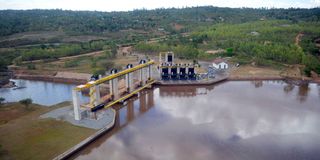We must secure water resources for prosperity

Sondu-Miriu hydroelectric power plant in Nyakach Constituency, Kisumu County.
What you need to know:
- A land of arid and semi-arid regions, Kenya struggles with a per capita water endowment below the global benchmark.
- Dams and reservoirs are the key to ensuring water availability for various uses, including irrigating our farmlands.
The challenges Kenya faces in water infrastructure development and service provision are stark and undeniable. A land of arid and semi-arid regions, the country struggles with a per capita water endowment below the global benchmark.
Climate change, with its unpredictable rainfall patterns, increasingly severe droughts and devastating floods, exerts immense pressure on our scarce water resources. Trans-boundary resource issues, low investment and burgeoning human settlements further exacerbate the problem.
Projections from the National Water Master Plan paint a clear picture: a sharp increase in water demand by 2030. This means that we must act decisively, strategically, and with a unified purpose.
The National Water Harvesting and Storage Authority’s strategic plan directly confronts these challenges by emphasising the critical need for enhanced water harvesting and storage infrastructure. Dams and reservoirs are the key to ensuring water availability for various uses, including irrigating our farmlands.
Our targets are ambitious, yet calculated and achievable; to increase water storage capacity by 125 million cubic meters by 2027. This task will be achieved through construction of major dams such as Siyoi Muruny, Soin Koru, Bosto, Umaa and Badasa. Beyond large-scale projects, we are also committed to encouraging household rainwater harvesting, targeting 100,000 homes, thereby empowering communities at the grassroots level.
Sustainable resource management
To further bolster our resilience against climate shocks, we plan to construct 360 small dams/pans and drill 203 boreholes for drought mitigation. We will also build and maintain vital dykes and river training structures to protect lives and property from devastating floods.
The impact of these projects will be truly transformative for our nation. The water stored will serve not only critical domestic and industrial needs but, crucially, will irrigate 22,000 acres of land, thus contributing significantly to our national food security.
Effective implementation of the strategic plan is paramount to its success. As we move forward, we are keenly aware of the dynamic external environment that will influence our journey. This includes political shifts, economic pressures, social changes, technological advancements, environmental imperatives and legal frameworks.
Each these influences our work, and we are prepared to adapt and innovate accordingly. We are poised to leverage opportunities presented by the growing population and urbanisation to develop crucial water infrastructure, while mitigating challenges such as compensation delays for land acquisition and the impact of economic fluctuations.
We will embrace new technologies, from Geographical Information Systems for real-time data and monitoring, to green technologies for groundwater assessment and sustainable resource management. Together, we can ensure that all Kenyans have access to this precious resource.
Mr Mugun is the CEO of the National Water Harvesting and Storage Authority


